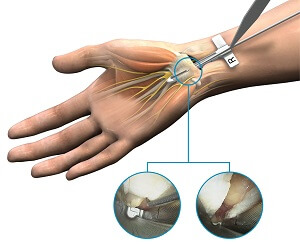How Much Does Carpal Tunnel Surgery Cost?
Last Updated on March 2, 2023
Written by CPA Alec Pow | Content Reviewed by ![]() CFA Alexander Popinker
CFA Alexander Popinker
Carpal tunnel syndrome, also called carpal canal syndrome, is a condition caused by compression of the median nerve in the wrist.
The carpal tunnel (TC), located at the wrist, more precisely at the base of the hand, is a narrow passage, surrounded by carpal bones arranged in an arch, and a durable ligament. The tunnel is crossed by the median nerve and nine tendons. Sometimes, the thickening of tendons or other structures narrows this tunnel and causes compression of the nerve.
How much does carpal tunnel surgery cost?
Carpel Tunnel surgery has an average national price of around $7,000 per hand. This cost is for those with no insurance, while those with insurance will face a copay of an average of $1,200. The copayment may include therapy, aftercare, and also rehab.
It is important to know that if don’t have any type of health insurance, the cost of Carpal Tunnel surgery varies between $4,000 to $12,000.
According to CarpalRx, the cost of carpal tunnel surgery is higher in a hospital than in a clinic.
In a clinic:
- Facility services: $1,297
- Doctor’s fee: $746
- Anesthesiologist: $408
- Total average cost: $2,451
In a hospital:
- Facility service: $4,200 (for a 2-night stay)
- Doctor’s fee: $746
- Anesthesiologist: $408
- Total average cost: $5,354
What factors can affect Carpal Tunnel surgery cost?
As with any surgical procedure, the cost of carpal tunnel surgery depends on many factors:
- The location area where the surgery will be performed;
- The type of facility where it will be performed; whether it takes place in a clinic or hospital;
- The experience and recognition of the surgeon;
- The type of surgical technique used, whether open surgery or endoscopic;
- The type of anesthesia administered, whether it’s local or total;
- If there are complications during the surgery.
Additional costs
There is a major additional cost to consider after carpel tunnel surgery. That is the post-surgical cost, which consists of physical therapy and rehabilitation. This is a quite long-term therapy and very expensive if you don’t have any type of medical insurance. Physical therapy and rehabilitation after carpel tunnel surgery can last between 4 months and up to one year, and the costs can go from $12,000 up to $29,000 with no insurance.
How to recognize Carpal Tunnel Syndrome?
Symptoms of the disease or manifestations in the early stages are intermittent numbness and tingling in the fingers I-IV, especially at night. Over time, numbness and tingling become permanent and upsetting, they turn into pain at night and cause the patient to wake up from sleep. The pain can also be accompanied by other symptoms, such as tremors, weakness, clumsiness, and atrophy of some muscles in the hand.
You might also like our articles about the cost of hand surgery, finger surgery, or Achilles tendon surgery.
Some patients describe sensations of tingling in the fingers associated with the need for taking the chill off.
There may also be a pain in the wrist, as well as atypical pain located in the elbow or even the shoulder. If not treated, the disease can develop into irreversible damage to the nerve through ischemia, and over time its complete destruction through demyelination and necrosis of nerve threads.
Why does carpal tunnel syndrome occur?
 Carpal tunnel syndrome can occur from a wide variety of causes.
Carpal tunnel syndrome can occur from a wide variety of causes.
Pathophysiology, the mechanism through which carpal tunnel syndrome occurs, is represented by neural ischemia, i.e., the insufficient blood supply to the nerve, caused by the narrowing of the channel through which it passes.
Hereditary factors can be a cause because some people are predisposed to carpal tunnel syndrome by the disproportion between the diameter of the osteofibrous canal and that of the tendons that pass through it. This explains the appearance of carpal tunnel syndrome seemingly without causation.
Certain occupational positions of the hand, using the keyboard and mouse, or excessive use of the hand often favor the appearance of compression.
Among the systemic diseases that can cause this pathology are diabetes mellitus, hypothyroidism, amyloidosis, rheumatoid arthritis, acromegaly, obesity, and chronic kidney failure. Excessive alcohol consumption as well as smoking can cause carpal tunnel syndrome or make it worse.
STC can also occur after or during pregnancy, due to hormonal changes that lead to excess water accumulation in tissues.
Other causes may be hand and forearm trauma, concussion, sprains, fractures, which favor or even cause carpal tunnel syndrome, and tumors or synovial cysts that may generate compressions in the canal.
Who is treating carpal tunnel syndrome?
When symptoms appear, you should consult a surgeon specialized in hand surgery.
The hand surgeon is the one who will establish the final diagnosis, based on the clinical examination and paraclinical explorations. He will also make appropriate treatment recommendations for each case, perform surgery, and coordinate adjuvant treatments, and post-operative follow-up.
Surgical treatment
It is the only type of treatment that completely eliminates compression. Compression is what causes the median nerve to suffer and all the symptoms associated with it.
Surgical treatment consists of cutting the fibrous structure of the transverse carpal ligament and thus increasing the size of the canal. It is an easy procedure for the patient to bear, of relatively short duration. Recovery and prognosis are very good if the treatment is done on time. If irreversible nerve changes occur, the prognosis is affected.
The most recommended method is the minimally invasive, open method with minimal incision, of about 2 cm. During this type of surgery, the surgeon manages to have a safe abord, avoids nerve damage during ligament sectioning, correct decompression, and almost invisible scar after healing.
Hospitalization, anesthesia, and duration of the intervention
The surgery is performed in a day-to-day hospitalization regime, and the patient spends about 2 hours in the clinic.
The procedure is usually performed under local anesthesia and is completely painless. After the installation of anesthesia, the intervention takes about 15 – 20 minutes.
If the patient has both hands affected, doctors recommend a series of surgery at a distance of one to two weeks. The most affected hand goes under surgery first.
What happens if you don’t get treated?
Carpal tunnel syndrome is a progressive disease, so it evolves more slowly or more rapidly but almost always worsens. Without a surgical decompression of the median nerve, this disease damages the health of the patient by completely destroying the sensitivity in the I-IV fingers. This leads to disorders and difficulty in handling objects and then the patient begins to drop objects from the hand. In the end, unbearable night pain occurs.
Carpal tunnel syndrome is a progressive disease that progresses slowly but surely. It is recommended that the surgery be performed at an early stage, before the onset of irreversible lesions.
Final words
The final cost of carpel tunnel surgery depends mostly on whether you have health insurance and the type of coverage you’re under. In case you don’t have insurance, and the cost might be a problem, you should do some research as the costs will vary based on where you live, in what type of facility takes place, what type of surgery you go for, and of course, how soon you recover.


Leave a Reply
Want to join the discussion?Feel free to contribute!